| |
Banstead, the second station on the
branch, is sited on top of a long cutting (formed by the
building of the railway) which at this point is some 30
feet deep.
First mentioned in an
Anglo-Saxon charter of AD 967, Benestede is recorded as a
settlement in the Domesday Book from 1086, most likely
taking its name from the Anglo Saxon bene
("bean") and stede, which refered to an area
which was populated but had no official status as such.
It was good farming land, and the gentry, church and
finally crown who owned the manor in succession found it
to be a very profitable feudal property before it was
passed on to the Carew family by Henry VIII. A village
had by then formed out of the previously scattered
hamlets, but even though Banstead Downs (which for many
centuries covered all the open land stretching from Epsom
to Croydon and Reigate) had its spell of horse racing in
the 17th century (Samuel Pepys recorded three personal
visits in 1663) and the town also gained a certain
reputation as a health resort for its "wholesome
air", Banstead's population remained low until the
late 19th century. This changed with the advent of better
roads and the coming of the railway, even though the
latter really didn't have that much to do with Banstead
village proper.
|
| |
Opened in 1865 together with the
branch, Banstead station is in fact over a mile
away from Banstead village (which is probably why
it changed its name to Banstead & Burgh
Heath in 1898 until the Southern Railway
reverted this back to the original name Banstead
in 1928).
The Ordnance Survey map of the
area from 1888 shows the railway curving away
from the village and passing through the open
countryside with no housing to speak of other
than a few scattered farms - true to its original
purpose and intentions, namely to provide access
to the Epsom Downs racecourse. There were
obviously hardly any potential passengers along
the line anyway, the total population in the
parish of Banstead being 1,270 in 1851.
|
|
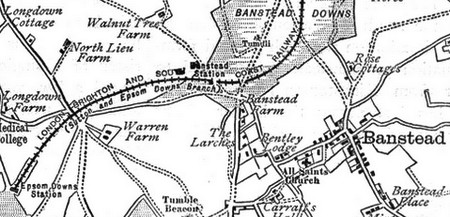 |
|
| |
| But railway
lines were a driving force of change, and even though the
original planners of the Banstead & Epsom Downs
Railway had never strived to attract housing developments
alongside their lines of track, this was precisely what
happened, as the Ordnance Survey map from 1896
illustrates. Banstead village had grown only very little,
but a substantial set of new houses had been built
between Warren Farm and the railway line for the
Kensington & Chelsea District School. |
| |
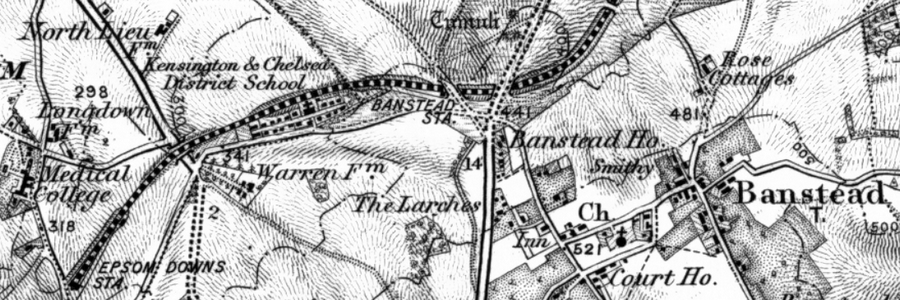
|
| |
Built between 1878 and 1880
this was a residential institution serving the purpose of
providing "education and apprenticing of poor
children" as set out in the 1834 Poor Law
Amendment Act, and the railway line was actively involved
in the construction work.
"The first village of any size
erected by the Poor Law authorities will be that at
Banstead, Surrey (...) The site of this village is a
long strip of ground comprising upwards of 27 acres,
adjoining on one side the Epsom Downs Branch of the
London, Brighton and South Coast Railway (...) The
material for the buildings is brought on to the
ground by means of a siding from the London and
Brighton and South Coast Railway, temporary lines of
rails being laid down through the length of the main
avenue; and the trucks are unloaded wherever the
material is required." (The Building News,
8 August 1879)
The first
children moved to Banstead in September 1880; the site
was renamed Beechholme in 1951. The school closed in
1974, and the site was redeveloped as a housing estate.
|
| |
| As traffic
flows came, changed, and went, all three stations on the
branch saw considerable changes in their track layouts
over time. Plans from 1865 indicate that both Banstead
and Belmont had goods yards as of the opening of the
branch, but somewhat mysteriously goods trains didn't
appear in the working timetables until 1872 (Kirby,
1983). The trackplan below indicates the single track
(black) that has served the station since October 1982,
along with track that existed around 1920 but has been
lifted over time (blue). |
| |
 |
| |
| By the end
of the First World War, Banstead boasted a complex and
intensely worked goods yard, along with three "chalk
sidings". The landscape in the area is a rich source
of that mineral, and given its many industrial uses
(cement, powders, fertilizers, lime production, etc.) was
extracted in large quantities and then loaded and
transported from here in railway wagons. |
| |
| The
comparatively busy goods operations at Banstead
can be glanced from these 1922 aerial views,
which also illustrate how sparsely populated the
area was at the time. 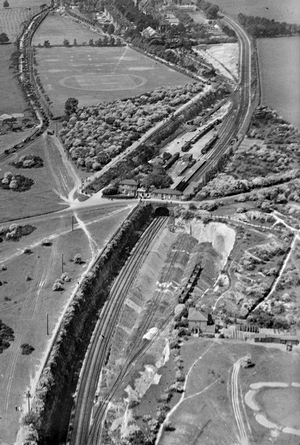
Copyright
National Collection of Aerial Photography (NCAP),
reproduced under license
|
|
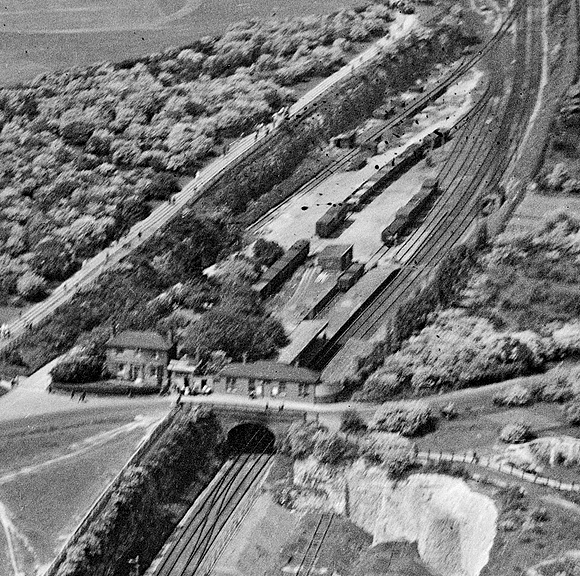 |
|
| |
| After
WW2 freight traffic decreased
dramatically; Banstead goods yard closed
at the end of 1964 and its track lifted.
The space (immediately adjacent to the up
line platform) has been used by various
builders merchants ever since. The
introduction of track circuit block and
colour light signalling in 1969 made
Banstead signalbox redundant.
More dramatic change came
about on 3 October 1982, when the entire
branch was reduced to single track as a
result of the destruction of Epsom Downs
signal box by fire in November 1981.
|
|
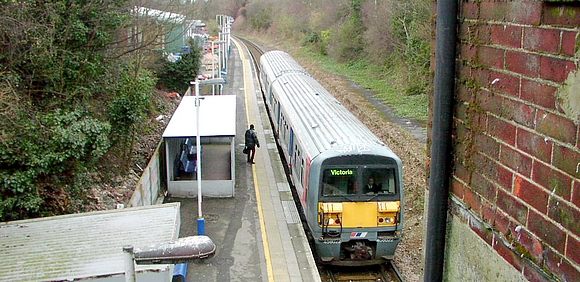
Class 456 #022 is ready to depart
Banstead for Victoria on 10 August 2006 -
the builders merchant's yard is visible
to the left of the platform (Robert Oakes
photograph, used with kind permission)
|
|
|
| |
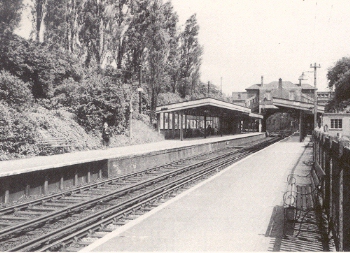 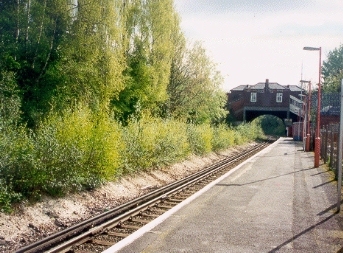 |
|
The
comparison of the view from the end of the
platform towards the station building in 1961 and
1995 illustrates the amount of change at Banstead
as a result of the singling of the line. The station building, however, has
remained virtually the same for decades in terms
of outward appearance.
|
|
| |
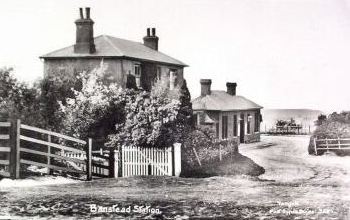
|
|
This
picture seems to be the oldest existing public
photograph of Banstead station ("Post
Office Series" postcard #358,
probably showing the station c.1900). The station
buildings from 1865 remained in their original
condition right up until 1935, when the constant
rise in traffic called for some alterations. The station is located in what
historically was an agricultural hamlet of
Banstead village, called Nork Close. The estate
was sold in 1923 to the
Halden Estates Co. Ltd. from London who started
the housing development that quickly turned into
a sprawling residential area. It also included a
row of shops in what came to be called Nork
Village (and which was only a short and easy walk
from the railway station) as well as detached and
semi-detached houses on Nork Way and Warren Road
(named after the old Warren Farm).
|
|
| |
| Nearly four
million houses were built in England between 1919 and
1939, and the vast majority of these (nearly three
million) were built in the growing areas of suburbia and
offered for sale, not rent. |
| |
| The
number of owner-occupied houses in
Britain thus soared from around 750,000
in the early 1920s to more than 3,250,000
by 1938 (Gardiner, 2010), and the
countryside along the Epsom Downs branch
saw an increasingly intensive building
activity. The Halden Estates Co.
Ltd. advertised their houses with a
poster proclaiming the simple message of
"Nork - live there!", and
although the company itself collapsed in
April 1925, the residential area
continued to grow. In 1927, the line had
seen the purchase of 3'000 season tickets
- by 1933, this figure had grown to
13'000 and was still rising (Kirkby,
1983).
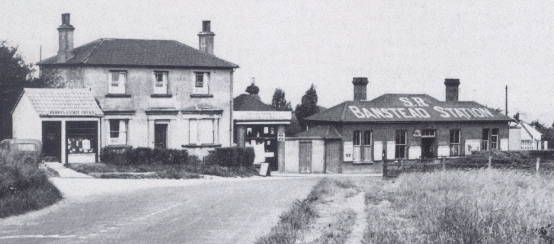
Banstead Public Library
|
|
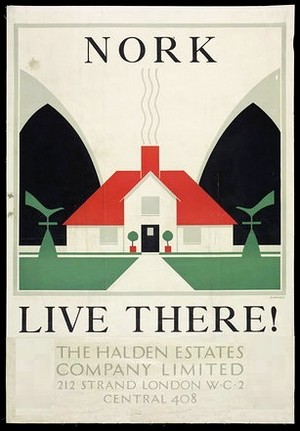
The V&A Collection
|
|
|
| |
| This view of
the station, taken around 1930, shows the
improved road surface and added lettering on the
roof of the station building to guide pilots into
Croydon airport. The house on the left was the
station master's residence, whilst a small
bookstall is squeezed in between the two larger
buildings. Apart
from losing its
two chimneys, Banstead
station's road-level frontage has since remained
almost unchanged over the decades since. |
| |
|
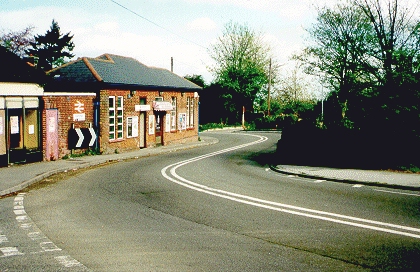
April 1995
|
|
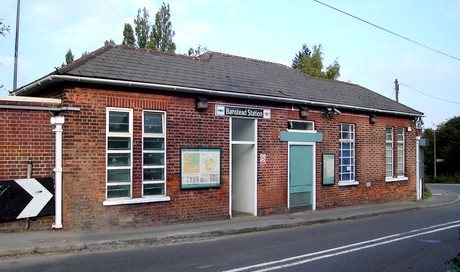
October
2007
|
|
| |
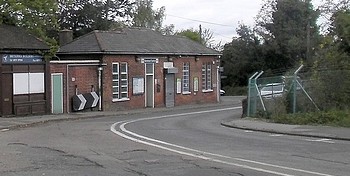
October
2012
|
|
The
interior, however, has seen a steady reduction of
room space serving railway use, with large parts
of the building now boarded up - ultimately
serving as nothing else than an entry point to
the platforms below. The original layout of the
station building had the entrance leading
directly to the booking office, with covered
stairways on both sides of the building leading
down to the platforms. These had been lengthened
in the 1930s and provided with canopies in the
1950s.
With
the singling of the track, the up platform was
put out of use and the covered stairway leading
down to it removed.
|
|
| |
| The
platform structure is essentially still there, but
ballast and dirt have been piled up against the now
heavily overgrown structure. |
| |
|
| |
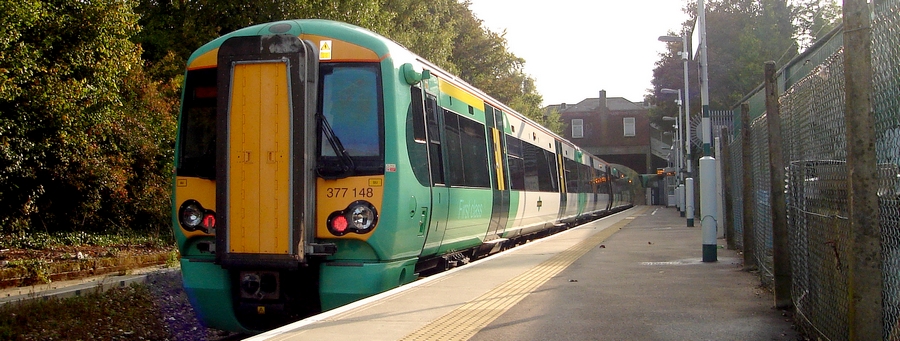 |
| |
| It had been a long time indeed since
passengers had been able to board a train and
take first class seats at Banstead, but this once
more became an option for as long as the Class
377 (dubbed "Electrostar" and actually
intended for outer-suburban and main-line
service) showed up occasionally on the branch for
a while in 2007 (this unit was on its way to
London Victoria on 6 October of that year). |
|
| |
| |
|
| |
For more information on the
local history of Banstead see the website of the Banstead History Research Group

|
| |
SOURCES
GARDINER
Juliet (2010) The Thirties: An Intimate History of
Britain, Harper Press
KIRKBY
J.R.W. Kirkby (1983) The Banstead and Epsom Downs
Railway, Locomotion Papers Series, Oakwood Press
|
| |
| |
Back to main index
|
| |
Page last revised: 20 October
2024
|
| |

(c) 1999 - 2024
|

